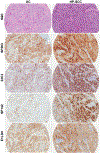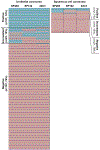PD-L1 Immunohistochemistry Assay Concordance in Urothelial Carcinoma of the Bladder and Hypopharyngeal Squamous Cell Carcinoma
- PMID: 29750666
- PMCID: PMC6750743
- DOI: 10.1097/PAS.0000000000001084
PD-L1 Immunohistochemistry Assay Concordance in Urothelial Carcinoma of the Bladder and Hypopharyngeal Squamous Cell Carcinoma
Abstract
Programmed death ligand-1 (PD-L1) immunohistochemistry is used to guide treatment decisions regarding the use of checkpoint immunotherapy in the management of urothelial carcinoma of the bladder and hypopharyngeal (HP) squamous cell carcinoma. With increasing PD-L1 testing options, a need has arisen to assess the analytical comparability of diagnostic assays in order to develop a more sustainable testing strategy. Using tissue microarrays, PD-L1 expression in tumor cells (TCs) and immune cells (ICs) was manually scored in 197 cases and 27 cases of bladder and HP cancer, respectively. Three commercial kits (Ventana SP263, Ventana SP142, Dako 22C3) and 1 platform-independent test (Cell Signalling Technologies E1L3N) were utilized. Across the 3 commercially available clones, 14% and 74% of urothelial carcinomas were positive and negative, respectively, whereas 7% and 78% of HP carcinomas were positive and negative, respectively. Twelve percent of bladder and 15% HP cases showed discrepant PD-L1 classification results. Regardless of the scoring algorithm used, E1L3N provided comparable PD-L1 staining results. Fleiss' kappa and intraclass correlation coefficient (ICC) analyses demonstrated substantial agreement among all antibody clones (k=0.639 to 0.791) and excellent reliability among SP263, 22C3, and E1L3N antibodies (ICC, 0.929 to 0.949) in TC staining. Compared with the other 3 clones, SP142 TC staining was lower with only moderate correlation (ICC, 0.500 to 0.619). Generally, the reliability of immune cell staining was lower compared with TC staining (ICC, 0.519 to 0.866). Our results demonstrate good analytic comparability of all 4 antibodies. The results are encouraging and support growing optimism in the pathology and oncology communities concerning strategies in PD-L1 assay use.
Conflict of interest statement
Conflict of interest disclosure statements:
• Dr. Downes has received compensation from Hoffman – La Roche and Astra Zeneca for participating on advisory boards and honoraria from Astra Zeneca.
• Dr. Xu has received honoraria from Merck.
Figures




References
-
- Speiser DE, Utzschneider DT, Oberle SG, et al. T cell differentiation in chronic infection and cancer: functional adaptation or exhaustion? Nat Rev Immunol. 2014;14:768–774. - PubMed
Publication types
MeSH terms
Substances
Grants and funding
LinkOut - more resources
Full Text Sources
Other Literature Sources
Medical
Research Materials
Miscellaneous

